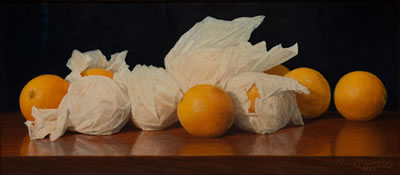In my last blog, I wrote about the results of the American auctions that had occurred in the previous week in New York. Among the lessons they taught, I said, was that the market for 19th century genre and still life paintings was “dead as a doornail.”
Spoken too soon. A couple of weeks after that post, the still life below by William McCloskey came up at a Grogan & Company fine art and jewelry sale in Boston. Estimated at $80,000-150,000, it sold for $488,000, including premium.

McCloskey (1859-1941) studied with Thomas Eakins at the Pennsylvania Academy of the Fine Arts, taught briefly in Denver, and then moved to Los Angeles, at that time a sleepy provincial town with pretensions to culture. While he enjoyed an active career in California as a portrait painter, McCloskey would be unknown today except for the paintings he made of oranges and other fruit, which have proved perennial favorites over the years.
In setting the estimate, Georgina Winthrop, the cataloguer at Grogan, was playing it safe. Although a similar McCloskey still life sold in New York for $782,500 in 2011, Ms. Winthrop obviously thought, as I did, that the current market for Victorian-era paintings was weak and that a conservative estimate was called for. Whether or not the low estimate and the non-New York venue encouraged collectors to think that they might get a steal, there was no stopping them once the bidding began. Six telephone bidders engaged in a bidding war, tripling the estimate.
Initial reports had said that the buyers of the painting were a young couple from San Francisco who had come to the sale to bid on an engagement ring they saw on Instagram. They saw this painting at the viewing, the story went, and decided to buy it.
While that part of the story wasn’t true, the description – “a young couple from San Francisco” – is enough to set any American dealer’s heart aflutter. Young? From San Francisco? Could this be the start of an influx of thirty-something Silicon Valley gazillionaires into our market?
I would have been delighted to learn it was so, but I wasn’t holding my breath. Look again at the painting above. It was painted in 1889, but it’s not Victorian. There are no tchotchkes, no damask tablecloth or 19th century bric-a-brac, just oranges and tissue paper on a bare wooden surface. It could have been painted in the 17th century or yesterday. Framed in Renaissance Revival frame, it would go well with Herter Brothers furniture, but put in a simple strip molding, it would go just fine with mid-20th century Danish modern. It’s timeless.
So as far as the market for American 19th century still life painting goes, the fruit paintings of McCloskey are a special case. Or maybe this is just proof of the truth of one of the three rules that Ira Spanierman, my first boss, used to propound when I was just starting out: “Portraits are hard to sell. Oval paintings are hard to sell. Still life paintings with oranges in them always sell.”
I would be happy to discuss these and other “rules” with you. Let’s talk soon.

